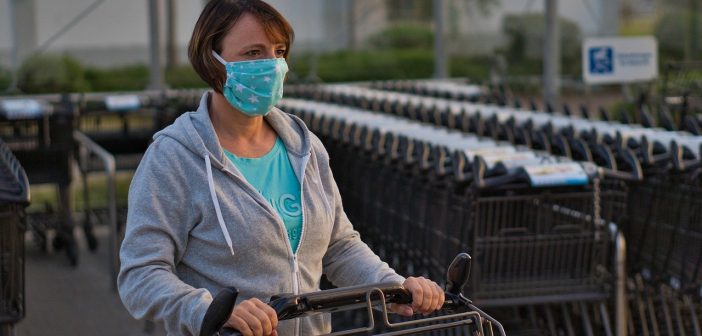Since its identification as a case of respiratory infection in Wuhan in December 2019, the novel coronavirus (SARS-CoV-2) disease, COVID-19 has spread like wildfire [1]. According to World Health Organization (WHO) more than two million people around the world have COVID-19 with a death toll in excess of hundred and fifty thousand [2]. On March 11, WHO declared COVID-19 a pandemic [3]. It has now reached almost every corner of the world, with Europe and Americas considered as the current epicenter of the disease [1].
Stages of COVID-19 transmission
Based on the pandemic transmission model [4], four stages of coronavirus transmission could be distinguished:
Stage 1: The cases are imported by the people from outside the community as a result of their travel to affected areas/countries.
Stage 2: Local transmission occurs from the infected returning travellers to their close one, e.g. friends and family. The number of cases is still small and is easy to track and isolate.
Stage 3: People with no travel history or contact with infected people start getting the disease. At this stage there is a rapid rise in the cases within the community.
Stage 4: An explosion of cases all around the country which becomes extremely difficult to control. China has already gone through this stage.
Generally, the epidemic curve starts to rise sharply during the third phase, also known as community transmission. But it mostly reaches it peak during the fourth stage. However, with appropriate prevention measures, the curve could be flattened at stage 3 so it does not move into stage 4.
WHO classification of the affected countries
WHO utilizes the phases of transmission to categorize affected countries into 4 clusters [5];
- No cases reported.
- Sporadic cases.
- Clusters of cases (grouped in place and time),
- Community transmission: this is where most countries are now in, or are approaching to. Even countries with initial success in controlling COVID-19, like Japan is experiencing a resurgence and is heading into community transmission.
How does it happen?
Community transmission is the main vehicle for turning the coronavirus infection into a dangerous contagion. The virus spreads through contact with infected person or contaminated surfaces [1]. Respiratory droplets from a case can carry the virus within a distance of six feet [1]. Mass gatherings provide an excellent source for the infection to affect large number of people at the same time. The cases then rise exponentially, with doubling of the numbers in quick succession.
There is still a lot we do not know about the coronavirus. Available data [1] suggests that the mean incubation period is 5-6 days, but it can be anywhere between 1-14 days. What is scary is that while people have been known to transmit the virus when they are expressing the symptoms, evidence has emerged to demonstrate that a lot of people continue to spread the virus without any visible discomfort. Such asymptomatic cases are impossible to identify without proper laboratory investigations. Asymptomatic cases have been touted as one of the big reason of massive community transmission.
Contaminated surfaces also played a key role in community transmission. A review published in the Journal of hospital infection [6] described that the lifespan of novel coronavirus on surfaces like metal, glass, or plastic can range anywhere from two hours to nine days. Another article [6] in New England Journal of Medicine showed that the virus can live on copper surfaces for up to four hours, on cardboard tops for up to 24 hours, and on plastic and stainless steel for two to three days.
Public Health Interventions
Community transmission calls for swift, intensive and concerted effort to contain the situation and flatten the epidemic curve. These measures should have been in place before the virus reaches stage 3 to manage the impact on health care services which are certainly going to be under a lot of stress. Common measures [7] like maintaining proper hand hygiene (washing hands for at least for 20 seconds with soap and water, using hand sanitizer frequently), covering the face with the back of the arm while coughing/sneezing, protective equipment while going out, tracing the travellers from affected zones and implement appropriate isolation procedures, quarantining the cases, tracing and isolating contacts, regular environmental cleaning etc. However, to prevent large scale community transmission and stop the virus from going into the 4th stage, drastic steps may need to be undertaken to limit public crowding, closing of places of gatherings (e.g. schools, parks, beaches), shutting down non-essential businesses and in extreme cases isolation of everyone in the community.
At the same time healthcare facilities should be prepared for the influx of huge number of Covid-19 patients. Facilities need to be equipped with ventilators, ICU and other essentials to meet the patient demands. Proper protocols must be put into place and all the health care staff dealing with COVID-19 must be supplied with protective clothing to ensure their safety while treating patients.
Our world is going through an event almost unprecedented in modern times. Counties are locked down, economies are stagnant, once bustling towns and cities look deserted. Everything we know about our world is changing. But one thing is sure; we are going to come out of this crisis stronger and more united.
References
1. Benjamin J Cowling, Allison E Aiello, Public Health Measures to Slow Community Spread of Coronavirus Disease 2019, The Journal of Infectious Diseases, doi: https://doi.org/10.1093/infdis/jiaa123
2. WHO. Coronavirus disease 2019 (COVID-19) Situation Report – 91
3. Cucinotta D, Vanelli M. WHO Declares COVID-19 a Pandemic. Acta Bio Med. 2020; 91(1):157-60. Available from: https://www.mattioli1885journals.com/index.php/actabiomedica/article/view/9397
4.ET online. Coronavirus: The four stages of a global pandemic; 2020. Available from: https://economictimes.indiatimes.com/news/politics-and-nation/coronavirus-the-four-stages-of-a-global-pandemic/stage-1/slideshow/74884278.cms
5. WHO. Coronavirus disease 2019 (COVID-19) Situation Report – 72
6. Migala J. How is Coronavirus Spread? Here’s What You Should (and Shouldn’t) Worry About. Available at: https://www.health.com/condition/infectious-diseases/how-is-coronavirus-spread
7. WHO. Responding to community spread of COVID-19, Interim Guidance. 2020







